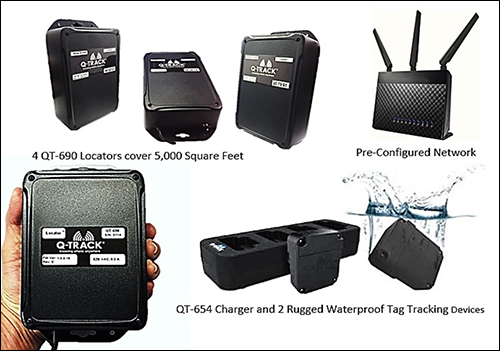Real-time location system (RTLS) company Q-Track Corp. has released an RTLS indoor location evaluation kit intended to lower the cost of entry for RTLS deployments to around $3,500. The kit aims to serve as a starting point for companies, the company reports, with two active RTLS tag transmitters, four “locator receivers” and software to help users identify the locations of those tags in real time. Following evaluation, companies would likely purchase more tags, and possibly more locators as well, to track more people or to cover larger areas.
The system targets companies wishing to monitor the movements of people, explains Steve Werner, Q-Track’s CEO. He envisions the relatively low-cost RTLS technology being used for monitoring employee security and safety, as well as medical, retail and service optimization, personnel training and workplace efficiency.

Q-Track, located in Huntsville, Ala, provides indoor location systems that accomplish location accuracy down to about 1 foot. Its customers include nuclear facilities and military agencies that employ RTLS technology for training purposes—to understand the movements of trainees and, therefore, the amount of radiation exposure to which they may expose themselves—as well as military contractors (see Urban Warfighters Train With RTLS).
The technology consists of Near-Field Electromagnetic Ranging (NFER) RTLS transmissions. The NFER system’s battery-powered tags transmit at a frequency between 1 MHz and 1.2 MHz, with a long wavelength that measures approximately 100 meters (328 feet). Each tag is uniquely identified based on the frequency at which it transmits, Werner says, adding that a full system can accommodate up to 84 tags.
“By using low frequency,” Werner states, “we don’t need as much infrastructure” as some competing RTLS solutions. “That’s a big advantage for us.” The locators are typically installed about every 60 feet. Each locator evaluates the near-field properties of the tag signals, then applies an RF “fingerprinting algorithm” to locate the tag to within a specific accuracy of about 40 centimeters (15.7 inches).
According to Werner, the low-frequency transmissions can easily penetrate walls, as well as people, so that signals are less likely to bounce or be obstructed within a building containing many rooms, or when multiple individuals are present. In fact, he says, the technology “thrives in difficult environments,” including nuclear facilities or prisons, in which there is a large presence of metal and thick walls.
With the kit, a user can capture RTLS data throughout an area spanning about 5,000 square feet. He or she would first install the software on his or her own PC, then load a map of the facility or coverage area into the system. The user must then calibrate that area by placing the locators at perimeters and walking around the space with the ruggedized, waterproof QT-643 tags. Every 8 feet, an individual holding a tag could stop and mark on the map where that tag is located. (The tags are rechargeable, using cradles provided in the kit). Users of the kit can cover more area if they acquire more of the system’s QT-690 locators.
The company’s goal, Werner says, is to provide a solution to companies that may have previously considered RTLS technology too expensive. He says retailers and other companies have shown an interest in the kit, as well as those in other markets, such as the entertainment industry. In the latter case, actors wearing tags, while moving around a stage, could have their location tracked. That information would then be paired with the spotlight system, in order to ensure flawless spotlight coverage during performances.
The kit is also expected to be used in medical offices, Werner says. In such a scenario, medical personnel and patients could wear or carry the tags, which would transmit signals to the locators. The software would then help the office understand how long each patient was waiting for an appointment, how long he or she was interacting with a health-care provider, and any areas in which there might be service bottlenecks.
The software can also provide analytics, including the distance travelled by a specific tag. By knowing, for instance, how much a health-care provider has moved, the system can help an office manager to understand when a more efficient process could be established for nurses or doctors. In fact, Werner says, the technology could also benefit restaurants, by enabling them to better understand how long diners wait for their food, how efficiently they are served and how quickly wait staff responds to orders.


